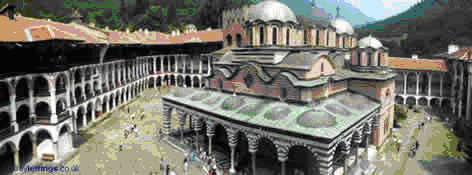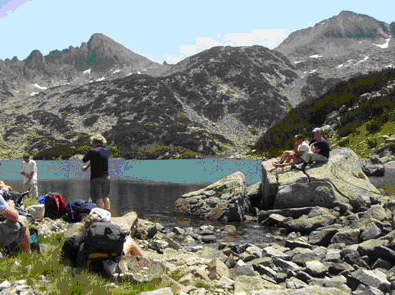History & Surrounding Area
Bansko has been declared a unique town of international importance to commercial tourism (1979). Apart from the beautiful Pirin and the numerous spots of natural beauty, the town also boasts many historic sites. Remains of ancient fortresses have been preserved in the Staroto Gradishte (Stankale) locality about 4 km southwest of the town and also in the Yulen locality (downstream Demyanitsa river). Thracian tumuli have been uncovered in the vicinity of Staroto Gradishte. Archaeological works have unearthed a 2nd century B.C. burial site containing a set of bronze surgical instruments, etc. in the centuries-old Dobrokyovitsa locality (west of Bansko). Scientists assume that a medieval settlement used to exist in the Sveta Troitsa (Holy Trinity) locality (northeast of town). Southeast of Bansko are remains of the late-medieval single-nave churches "St George" and "St Elijah".
Bansko is an important cultural centre for the region. According to historic records, the settlement was first established about 9th -10th century A.D. on the site where ancient Thracian settlements had existed. In the 18th century it was mentioned as a large and prosperous village of thriving crafts and trade reaching as far as the Aegean and Europe.
Bansko is the centre of a historically important arts school. In the 18th and early 19th century talented painters and woodcarvers created works of art in the houses and churches of Bansko, the Rila Monastery (below),

the monasteries on Mount Athos, Serbia and Macedonia. The most famous painters belonged to the Molerovi clan, starting from its founder Toma Vishanov. During the second half of the 19th century another group of painters lead by Usta (Master) Ognyan Ognev made the decorative elements in the "Sveta Troitsa" church, Velyanova Kashta etc. Also famed were other craftsmen and painters such as Angel Velyanov, Mihalko Golev, Dimitar Sirleshtov , Ivan Terziev, Nikola Benin. Bansko gained renown for its woodcarving and local masters.
A monastery school was opened in Bansko in 1817 or 1838 and in 1848 a "mutual school" was founded. Bansko is the birthplace of nationally admired enlighteners, revolutionaries and poets such as Paisii Hilendarski - the author of "Istoriya Slavenobolgarskaya" (History of Slavo-Bulgars)(1762), Neofit Rilski - the founder of secular education and the first Bulgarian encyclopaedist, Nikola Vaptsarov - a remarkable Bulgarian poet of international renown.
Original fortified and artistically decorated houses have been preserved from the 18th and 19th century, built almost entirely of stone, with small barred windows, tall walls, heavy metal-plated gates and interconnected by narrow and winding cobble-stone streets. Remarkable as architectural monuments and examples of fine art are the Velyanova, Benina, Sirleshtova, Todeva, Molerova, Dragostinova, Sharkova houses. The Sveta Troitsa church, the bell tower with the big clock, the medieval church "Assumption of the Virgin Mary" with its remarkable wood-carved iconostasis make for fine accents in Bansko's atmosphere. Also noteworthy are the museum houses and collections, souvenir shops and romantic holiday residences, hotels and taverns cuddled in the narrow and picturesque streets.
The thing that attracts hundreds of tourists to Bansko is the unique combination of natural beauty, climate and mineral waters of the town, as well as its atmosphere, typical of the Bulgarian National Revival.

Unique are also the numerous mountain massifs and reserves. The town is the gateway to the most attractive part of Pirin with its symbols - the wild goat and the edelweiss. The incredible relief formations that attract Bulgarian and foreign tourists are: the Koncheto, the Banski Suhodol circus with one of the few snow-patches in Bulgaria, the Bunderitsa and Kazana caves, which are among the deepest in Bulgaria, the Yulen nature reserve and the crystal lakes - more than 100 in number. Thirteen major mountain routes and seventeen secondary ones have been developed within the territory of the Pirin National Park to serve the purposes of summer-time tourism. Rock scramble is allowed on six sites. In the high alpine part of the mountain summer-time accommodation for tourists is offered in eight mountain chalets and five shelters.
Bansko has a specific climate. The Aegean-Sea waft combined with the crystal clear water of Pirin attract lots of tourists during the hot summer days. The warm mineral water springs in the villages of Dobrinishte and Banya have proven healing properties. They are a good precondition for development of spa treatment in the municipality. The exceptional architectural style typical of the Bulgarian national-revival period and the historical and cultural heritage of the town create favourable conditions for development of congress and cultural tourism in Bansko.
Modern Ski Zone
The town nestling in the most beautiful alpine part of the 'mountain of gods', Pirin, offers excellent conditions for mountain sports and tourism. Unlike the other winter resorts, Bansko offers tourist accommodation in the town only, where there are 4200 beds [although this is increasing year on year]. The local people's hospitality is well known. They mostly meet tourists in their small family hotels and guesthouses.In winter a modern gondola lift takes skiers from the town to the Bunderishka Polyana area. There is a way station at Chalin Valog. The cabin capacity is 2400 people per hour. Apart from the cabin lift, there is also an asphalt-covered road from Bansko to the Vihren chalet, which connects the ski-zone in the alpine part of the mountain with the town. A ski path has been made from the first lift station to the Bunderishka Polyana area and skiers use it to race downhill to the resort. The ski path will be covered by snow with artificial snow machines throughout the winter season.
A quad-chair lift equipped with a transparent plastic screen now operates at the top of the ski area. The Austrian company Doppelmayer is the manufacturer of all new ski facilities in Pirin: a cabin lift, three quad-chair lifts, two ski tows of the anchor type with a capacity of 900 persons per hour.
The concessionaire Yulen JSC has projected a mobile revolving path for the youngest skiers, as well as new amusement trains and a kindergarten.
New possibilities are opened up for snowboarders with the special half-pipe facility. A modern chip card system provides access to the cabin lift and the other ski facilities in the zone through automatic opening of the entranceway when the card is regularly validated. A deposit is paid for every card, which is refunded upon return.
Large-scale construction is going on in the resort presently.
Today's construction contains elements of the typical architectural style of Bansko. The new hotels and complexes are built with materials that are traditional for the town – faced with wood and round stone, which helps preserve the architectural styles of the town; and its central area is built in a style typical of the national-revival period which remains unchanged and is kept as a monument of culture.
A lot of old recipes have been preserved and the present-day inhabitants of Bansko prepare delicious specialities. Guests can taste the culinary specialities typical of the season in the famous taverns. There are more than 150 and are furnished with antique furniture in the old style of Bansko.
The Magnetism Of Bansko
Sports and cultural calendar of Bansko:
The sports events and the long list of cultural happenings in Bansko ensure pleasant experiences for the guests of the town throughout the year. The small town of the Bulgarian national revival hosts a number of big sports competitions in both summer and winter.
Some of the traditional annual sports competitions are: the International Arm Wrestling Tournament carried out in May every year, the International Football Tournament for the Tanne Cup, again in May, the Republican Orienteering Championship, the high cross-country capability car racing and others such events.
Bansko has an extremely rich catalogue of cultural events. Some of them have preserved the traditions in folklore & custom: woodcarving and painting are of regional importance. These are the traditional holidays of Bansko, celebrated in May every year and on the Day of Bansko, 5th October.
Tourists are greatly interested in the annual culinary exhibition of Bansko's dishes and specialities, the Easter and Christmas celebrations, the New-Year kukeri (mummers) competition, the numerous folk concerts and Bansko national costume reviews, the religious and everyday traditions preserved up until now.
With its centuries-old culture inherited from the past and with its various cultural forums carried out here, the mountain resort may freely call itself a “Festival Town”. The festivals hosted by Bansko are quite different in nature and themes. In between Three Mountains is a folklore festival for authentic Macedonian songs. Both Bulgarian and foreign singers, mostly from the neighbouring countries Greece, Macedonia, Serbia and Turkey perform in it. The festival has a history of over ten years and is carried out like a competition. So far, performers from over 20 countries have appeared on the stage of the prestigious International Jazz Festival. The big rock concert of stars of the 70s and 80s organised by the TANNE Hotel, which continues for 8 hours, has established itself as an annual event. The children's festival under the auspices of TANNE Hotel gives an opportunity to young talents from the municipality of Bansko to perform and make their talents known.
Everything the visitor discovers here - history, culture, traditions and customs, specific cuisine, ancient architectural style, authentic folklore, and rich literature, makes the small mountain town from the national revival a peculiar symbol of the Bulgarian spirit and arouses interest in it. This is where its magnetism lies. No other town offers possibilities for mountain tourism and winter sports and competitions, for congress, eco and country tourism, for alpinism and spa treatment, angling, mountain cycling, and summer & winter walking tours in the mountains. And the mountains which are rich in crystal clear lakes and natural sites offer fascinating routes. This is why thousands of tourists pass through this place to rediscover Bansko and Pirin - two names associated forever with the unique magnetic power of genuine beauty.
For what ever reasons you choose to come to Bansko, you will leave the mountains with a sense of discovery, relaxation, and the desire to return here in the not too distant future.
Enjoy.